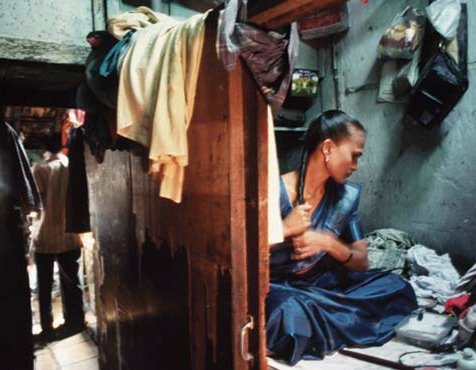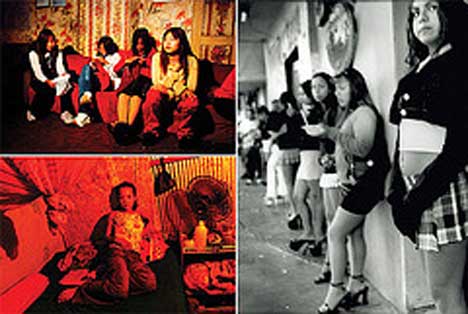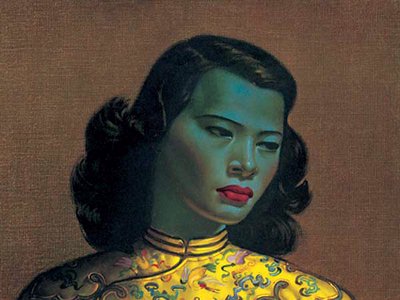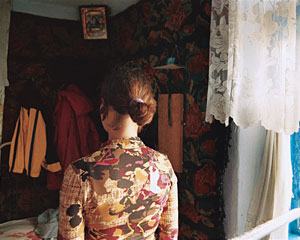 |
||||
|
The Colonization of the Female Body
By Christina Leano - June 2011.
The feminization of poverty is a phenomenon that has been experienced the world over. Due to the changing global and economic networks that the international arena has experienced through capitalism, liberalization, privatization, and changes that have occurred after the Washington Consensus Third World countries have felt a new type of imperial outreach and neo-colonialism that has led to economic and social detriment for the people and land. The unchecked growth of globalization feeds on the poor robbing them of lands, exploiting their labor, and driving women as well as children into prostitution. Poverty, unemployment, and the lack of formal jobs puts a major strain on women- as the men have a harder time securing employment women have to supplement the family income by working in the informal sector. Often times women are exploited as low skilled laborers and are paid very little for factory jobs, taking in people’s clothes to wash, and turning towards prostitution and the sex industry. Selling sex has become an important developmental tool in some Asian countries such as Thailand, Bali, Malaysia, and the Philippines. “Estimates claim that in Thailand, the sex industry became one of the largest contributors to the gross national product because it brought massive foreign capital into the economy” (Thislewaite 10). The exploitation of the rich Western neo-colonialists in the forms of military, businessmen, and tourists has fostered the growth of the sex industry in Asia making it the only lucrative source of income for the poor and uneducated women. “The sex industries are the institutionalized sexual use, by the more powerful members of the male-dominant societies, of the less power. This involves financial transactions focused on the sexual use itself” (Thislewaite 15). Patriarchy and hierarchical dualism, which the social construction based on privileging one class and subordinating the other due to beliefs of superiority versus inferiority is highly ingrained within prostitution. Patriarchy has socialized society into believing in male dominance and their ownership of women and entitlement to women’s bodies as well as sexuality. A patriarchal framework of society coupled with racist overtones is what has made prostitution, specifically prostitution in Asia so prevalent as well as popular with Western men (American, Canadian, European, Japanese). There is a racist hierarchical dualism that is involved that gives rights to rich males to get on an aircraft and travel across the world in order to exercise power and money over others. Asian sex workers are seen as the “other”, the colonized and not fully human. “Traveling abroad for sex implies that you can do things with foreigners that you cannot do at home, which is a racist assumption” (Seabrook 2).
Westerners have come to view Thai women- and Asian women in general- as more tender than sex workers in the West, they are seen as more compliant, eager to please, and considerate. Western men like the docility of Asian women, this perception has become ingrained in them through the centuries of dealing with Asia through a colonialist standpoint. This is the reason for the popularity of Asian sex workers with Western men, they are given the sense of power over a “lower class” of human beings, they feel patriarchal as well as racial superiority, and Western men feel a sense of disconnect with their Asian prostitute as opposed to a Western prostitute since they attribute a feeling of “otherness” due to not considering the women as fully human. Western usage of Asian women is another detrimental effect of imperialism and First World prowess. Women and children are forced into dangerous exploitative measures and are used as commodities to satisfy the needs of the rich white man. The military is a large abuser of the sex industry, in many areas around the world where military bases have become set up there also grows an economy that is based on the sex industry in order to cater to the military’s needs. Many bases are crucial to the economic survival of their surrounding communities. The Philippines for instance, had many American army and air force bases in the country and as a result many bars, clubs, and hotels have been built around the base in order to serve the entertainment purposes of the G.Is. The military often acts as a reminder of colonial superiority and imperial overstretch especially when they are occupying a country. Not only does the military physically occupy a country but they also use the people in the occupied lands. Military men are inculcated with the ideas of racial superiority, patriotism, and hypermasculinization. Hypermasculinity within a culture’s structure is the cultivation of masculinity that especially emphasizes dominance, control and strength. Men are socialized to believe that women will and ought to serve their sexual needs and that access to women is their right, this is what the patriarchal view centers on- the idea of male superiority and women being considered as property. Male domination and entitlement comes with being the colonizing force- they feel that they have a right to the land and the tourists who now visit Asia on sex tours feel that they have a right to the people. “The sexual use of women is tied to men’s power to control and dominate those with less power, and their sense of entitlement extends to those perceived as vulnerable to domination” (Thislewaite 16).
The denigration and racism held by the military is reinforced by the dehumanizing military propaganda about the enemies, this is the reason that service men are complacent about the gross usage of foreign women as sexual objects. “War and preparation for war has been a major factor in the increasing number of women and children in the sex industry” (Thislewaite 113). The bodies of women become another means of dominance over the enemy, it is another form of military conquest. The Japanese military first used poor Japanese women to travel with them as comfort women, as World War II evolved the Japanese government and military committed more egregious crimes against women, and Korean women in particular, since they were considered the occupied country. “As the Japanese advanced in their attempts to colonize Asia in early twentieth Century, they kidnapped, deceived and forced approximately 200,00 Korean, 800 Taiwanese, 60,00 Indonesians, Chinese and Filipino women into brothels as sex slaves, whom they euphemistically called comfort women” (Thistlewaite 72). The military socializes men into very violent worlds and emotional disconnect so that they begin to have little moral accountability and less regard for the sovereignty of women. The crimes that Korean comfort women experienced as sexual slaves during the Japanese occupation were devastating and little reparation has been paid to the women much less an apology by the Japanese government. The women were repeatedly raped and given #606, an arsenic that supposedly treated syphilis and prevented pregnancy. “I was a “comfort woman” between the ages of 14 and 19. Most of the girls were 16 to 19 years old. They all had been abducted and brought to the camp like me. During those years I received about 12 soldiers by midnight. After midnight one soldier often stayed with me through the night. Weekends were much worse. I was forced to service men from early in the morning to late at night with almost no time to rest, then spend the rest of the night with yet another man. Frequently I did not have time for a meal. On days like this I became feverish. Some girls serviced up to 50 men a day.” (Jin Kyung-paeng, 72 year old former comfort woman) War and military occupation are detrimental side effects to poor countries and many more deteriorating side effects for women often go unrecognized. The Thai sex industry had its major start during the Vietnam War as their country was commissioned to be a station for American G.Is as a spot for R&R, or rest and relaxation. The Philippines also got its start as an R&R spot for American soldiers during the Vietnam War, however the sex industry grew after several American military bases were contracted such as Subic Naval Base, Clark Air Base, and the US Naval Communications Station.
The Philippines has been marred with the history of colonization starting with the Spanish rule. In pre-Spanish Philippines, women enjoyed relative equality with men, it was an egalitarian society that has respect for women and mothers. When the Spanish arrived they imposed Catholic patriarchy as well as the idea of white, Eurocentric supremacy. Women had to be subordinate to fathers, husbands, and priests. Many of the indigenous Filipinos were raped by the Spaniards and then transformed into prostitutes. This is the first incident of the usage of indigenous women’s bodies by the imperialist power, however it has continued with Americans and Japanese entering into the Philippines and using their economic and political prowess to extract raw materials, cheap labor, and female subordination. The Spanish colonial rule ended after the United States defeated Spain in the Spanish-American War. Then there was the US colonial rule until World War II when the Japanese occupied the Philippine lands. After the Japanese occupation the country was left in such ruins and poverty. “Desperate for American economic aid, the government of the Philippines agreed to ruinous trade agreements with the United States and a ninety-nine years lease on a number of military and naval bases in the Philippines over which the US government exercised virtually all territorial rights” (Thislewaite 52). The Americans built many stations such as air force and naval bases, communications centers, and naval radio centers. Subic Naval Base and Clark Air Force Base were the largest are considered a valuable strategic standpoint in the Northeast Asian region. The bases serve as a springboard for US intervention in the internal affairs of their host countries as well, which is a major force in neo-imperialism. What grew around the American bases and ports of arrival in the cities of Olongapo and Pampanga was a sexual service sector devoted to the American clientele. Olongapo used to be a small fishing village but its conversion into a naval base by the American transformed it into a city of hotels, saunas, massage parlors, and women for sale. The Philippines has served as a popular R&R stop for Americans during the Vietnam War, Korean War and also during the Gulf War, since the sobering atmosphere of the Muslim countries necessitated the G.Is to find sexual satisfaction in the shores of another country. 7,000 to 10,000 sailors would disembark into the throngs of women ready to greet them because of poverty they face in life. The internal rape of the people and minds as well as the pejorative international reputation that the Philippines receives does more harm than good for the country regardless of the foreign income that is brought in (though when actually tabulated is very little). “The US uses the Third World like a man uses a prostitute. Flirts with her a little, pretends she is human, maybe spends a little money on her to make her pretty, then, when he has got what he wanted- the natural resources, control of the economy, a dumping ground for useless commodities, complete subservience- he treats her like a whore” (Thislewaite 54). Poverty is an obvious push factor for the reason as to why so many women have had to resort to prostitution in order to make a living and help with family financial needs. The Philippines has had a long history of foreign rule that has made it difficult for the government to stricken ties with its past imperial rulers. The American as well as the Japanese presence and increasingly the Europeans have made it easy for women to fall into the sex industry, since this is what the foreigners look for. The Philippines also has an unstable job market, high unemployment has experienced natural calamities in the early 1990s such as massive loss of land, property and jobs. The Philippine economy is wrought with debt and inflation, which does not make the country attractive to foreign investors. The unstable government and erratic environmental climate accustomed to having earthquakes and El Niño does not ensure investors.
|
|
|||
|
|
||||
|
This lack of foreign direct investment makes the country less competitive in the manufacturing sector that leads to a stunted domestic industry and makes it difficult to provide jobs for citizens. “Fiscal deficit and the national government debt are the Achilles heel of the Philippine economy” (asiandevbank.org). The Philippines has steadily declined in world market exports since the 1980s making it necessary for them to borrow international capital, this is a reason for the high inflation rates. The lack of exports is due to the highly competitive industries seen in China, Indonesia, and Vietnam, which are all able to produce electronics with higher quality, cheaper labor and more advanced technology (asiandevbank.org). Another imperialistic act imposed by the Americans was the Bell Trade Act which granted unlimited entry of US imports but exports of the Philippines such as raw materials like coconut oil and sugar were given quotas- this protected the American agricultural sector but led the Philippines into further demise. The poor women in the country who have no education or lucrative job offers in the formal economy see no other way but to go to the cities of Manila, Olongapo, and Angeles in order to prostitute themselves to American GIs for enough money to eat. The sad truth about the Philippine sex industry is that that women are being exploited by neo-colonialist invaders who do not regard women as entirely human deserving of respect and the women do not gain the large percentage of money which instead goes to the pimps, bar owners, and tour companies. The rich countries become richer and the poor become poorer and more exploited. The tour companies and hotels are usually foreign owned, either by wealthy Chinese or Japanese businessmen, in Thailand many of the brothels are owned by Americans. Many of the sex tours that come to the Philippines are of Japanese businessmen, the money mainly goes to the tour organizer which is usually organized by the home country. The Japanese tourists pay the cost of the night to package tour operators and the women who perform the sexual service receive 100 pesos or about $5. This is just another blatant example of exploitation of the richer countries, Japanese businessmen rather flock to poor Asian countries because they can get more from the women living in poverty. “As many as half a million working class Japanese men per year flock to the Philippines and Korea on kisaeng (geisha) tours, where the women are far more affordable than the exorbitantly priced Japanese geisha” (Thistlewaite 120). Detrimental effects that the Philippines has incurred as a result of being abused as a colonized entity is the internalized idea of inferiority. Not only do the women and people have to deal with growing numbers of venereal diseases and unwanted births of Amerasian children- the children begotten of sex workers and American G.Is or tourists- but due to the centuries of colonial influence the Philippines has internalized an idea of inferiority in relation to the white man. The Philippines had been a US colony and still has many ties with America. American style, culture, and people have a great influence over the Filipinos. American culture has created a growing sense of materialism; at times this is what drives the poor women into prostitution, it is the only way that they can pay for their families to gain material goods. Self internalization of inferiority has made it possible for the Western man (white and Japanese) to exploit to “brown” bodies of Filipina women. Imperialism and dualism based on a superior and inferior creates racist tendencies and images. The West view Asian women as exotic, lusty, not worthy of respect- they are malleable women of the East who are meant to be used for pleasure and recreation. On the other end, because of the difference in power structures of Third World and First World and the fact that the Philippines has come to associate the US as rich and powerful the people have come to idealize the West, America, and the idea of “whiteness”. Filipina women remain mesmerized by the rich white male. They idealize the “rich” white man who will rescue them with their economic prowess. This belief held as a truth will keep Filipinos and in particular women in a subordinate role. Thailand is the most infamous Asian country known for its sex industry, there is virtually every type of sexual deviance that can be bought in the country, such as gay sex, transvestites, pedophilia, and thousands of women working in bars, hotels, massage parlors, and brothels. Thailand is known as the “Brothel of Asia” in which estimates are that one third to one fourth of all young Thai women work in the sex industry. The growth of the sex industry has come with globalization. Globalization intensifies displacement and use of indigenous populations for little pay and therefore has replaced slavery. Liberalization, privatization, deregulation, of economies, the dumping of goods, and the competition brought by big businesses eat out the struggling Thai industries. Therefore, women’s work has been affected, such as factory work in the textile, electronic and food industries. Women have poor working conditions, no voice, and no right to unionize. “Imperialist globalization pushes women into the informal economy” (Ghosh 50). Globalization, which makes it easy for international travel and restructuring of industries to cheaper locales, has brought the modern day slavery of prostitution. In Thailand, the poverty was made worse by land conversion and demolition of urban and rural communities. Many fishing villages have been extirpated to make room for industrial plants or roads, this has polluted the rivers and agriculture plunging many rural farmers into poverty. The environment in rural areas has been devastated from deforestation by lumber industries. Natural resources have been abused and farmers have no more fishing grounds. Sometimes these families have no other choice but to sell their children into sex. The average prostitute working in Bangkok makes up to twenty times more than the wages of a domestic worker. These young girls feel obligated to go into the sex industry because they see it as the only way to earn a living and support their families. In Asian culture it is very important to be an “obedient” daughter and give back to parents, there is less of a sense of self as in Western culture and a high importance is placed on the kinship familial unit. Remittances coming from daughters working in the urban sex sector going to the families living in rural villages is close to US $300 million (Lim). “Women arrive daily in Bangkok from the countryside to swell the huge industrial reserve workforce in the capital. Untrained in any skills, with the basic minimum education, they can get less than the subsistence needs and they have no other ways than to sell their bodies” (Ghosh 61). Recently Thailand has seen an economic boom with the growth of industries, the building of complex infrastructure, and more foreign direct investment being placed within the country- however, the wealth is not equally distributed and a large majority of the population is subjected to living in slums. Thailand is coming to be seen as an Asian tiger, many investment bankers, creditors and dignitaries come to Thailand but the government makes sure to keep the seedy underbelly under wraps. When the Asia-Europe meeting was held in Thailand in 1996 the government declared a two-day holiday, this was a ploy in order to “hide” the true horrors of traffic, pollution, and overcrowding. Large projects that have started in Thailand are racing to globalize the economy. However, Bangkok skyscrapers, road networks are not benefitting the civilians. The decline in growth of the agricultural sector and the inadequacy of job supply in the industrial sector has made it necessary for so many of the Thai population- women, children, and boys- to be part of the “entertainment” and tourist industries, i.e. selling sex. “Patriarchy has long defined the lives of women and in present day society of economic liberalization again patriarchal biases and double standards of society stigmatize women in prostitution and justify the exploitation of women for huge profits” (Ghosh 54). The Westernized restructuring towards capitalism and the development of Western industries and multinational corporations within the country has a somewhat negative effect on the rural Thai civilians. They have seen the eclipsing of their agricultural lands as well as industrial jobs but the growth of and push towards tourism has inevitably spurred Thailand to market itself as the pleasure destination of the world. Poverty is the intensification of a sense of powerlessness and the growing inability to control one’s personal life. But many countries in the world are poor, how come they have not become known as the international capital for sexual service? What has made Thailand the infamous liberal Brothel of Asia? Thailand has come out of the sense of liberal religious structure of Buddhism which does not place such strict restrictions on sex or have the heavy moral judgment that Catholicism and other religions place on sex and sexuality. In Buddhism, sex is not sinful anyone can pursue the path of enlightenment. “Being a sex industry worker can be seen as a sign of karmic impurity and not sexual or moral impurity. Therefore, since one can always improve ones family financially, prostitution can serve good aims” (Thislewaite 65). Unlike the indigenous matriarchal society of the Philippines, Buddhism views women as the less spiritually advanced human, this is the reason they have been reborn females and not male. Religion is where the rules of social conduct is learned and therefore in Thailand, society has been socialized into an orthodox patrimonial religion that has a low regard for women and touts the masculine superiority. This type of chauvinistic framework has cultivated a society where men are allowed to have prostitutes and not view women as qualified people. Thailand’s historical tradition has made it acceptable to have a major wife, minor wife, a formalized mistress, and hostess or brothel prostitute. Buddhism is the main religion however there are traditions in Thailand that has come from other religious rites. The Hindu religion has influenced Thai kings to view women as symbols of entertainment in the royal court. “Under Hindu influence a woman is nothing, she is valuable only when she becomes a wife or mother of a baby. In the Thai dictionary a wife has been defined as ‘a person who is dependent on her husband’, while a husband has been defined as a possessor. The society permits a man to forge relationships with opposite sex either at pre-marital and also extra marital level” (Ghosh 36). The characteristic of Thai society and religion that provides the flexibility to adopt foreign elements of culture into the social framework has made the country pliable towards sex service. Therefore when globalization arrived and Western ideals permeated the country that wanted Thailand to be contracted as a rest and recreation region for American military men, the flexible Thai culture saw the profit and became the leading providing in selling sex. “By 1970, spending in Thailand by the US military personnel exceeded twenty million dollars” (Seabrook 7). At first prostitution was made illegal with the Prostitution Suppression Act of 1960 but in 1966 the Entertainment Places Act was enforced which regulated nightclubs, dance halls, bars, massage parlors, and other places where women attend to male customers. Thailand then came to an agreement with the United States military to allow the US soldiers who were stationed in Vietnam to use Thailand as an area for R&R. During the late 1960s during the major years of the Vietnam War the Thai economy experienced a large boost in their economy and an increased amount of US currency, this was all due to the business that soldiers brought into Bangkok when they came for their R&R breaks. The development of the country became dependent on the sex industry as a source of foreign revenue, Thailand was given loans to develop and fix the country, they created new roads, hotels, and buildings. When the war ended and the Americans went home the Thai economy felt the inflow of revenue dwindle. Determined not to let foreign investment go, the Thai government heavily marketed the tourism industry, which meant that the main attraction was women as commodities. “Patterns in worldwide business travel including the decline in airfare to Asia, have fueled Thailand’s search for foreign capital through the bodies of women” (Thistlewaite 58). The former vice president Boonchu Rojanasathian encouraged the sex industry because it brought in such high revenues from foreigners, he believed that the growth in tourism that Thailand was experiencing was positive because it “created jobs in the country”. Even the World Bank and IMF encourages the tourism industry in Thailand because they see it creating profits that deliver much needed foreign currency. “Because the north’s environment is beautiful, more and more land is being snatched from local villagers to make way for golf courses, hotels, and condominiums” (Ghosh 74). With the lack of formal economy jobs, agricultural work diminishing due to the eradication of natural resources, and unfair trade rules in which Western countries flood Third World markets while keeping their economies safe through quotas, Thailand has decided to gain comparative advantage in selling sex.
The Thai government has used its country’s women to develop the tourism industry which caters to Western travelers who can come into the country and buy virtually anything due to the high exchange rate. Through the denigration of women, young girls, and young boys neo-colonialism and Westernized global restructuring of economy shows how the powerful players are able to exploit people and resources for capitalistic gain. Popular travelers to Thailand are Germans, Dutch, Americans, and Canadians who call Bangkok the “Mecca of Eroticism” (Ghosh). The role of the state in post WWII period which followed the Washington Consensus marked with policies such as economic liberalization and the promotion of tourism to gain foreign direct investment. However, closely allying itself to Western needs has plunged the women into sexual slavery and subordination. The fact that tourism to Thailand brings in more foreign income than any other single source has created the cycle and need for sex tourism to continue because without it thousands of women and unfortunately children as well, will be left with no source of income. Despite the “income” that prostitution brings the detrimental effects to women are huge since large numbers of women have began to contract venereal diseases and HIV, an epidemic brought on by tourism. The majority of tourists who come to visit Thailand are men either on “business” or blatant sex tours. The flight that comes back from Bangkok to Germany is jokingly, however is probably taken literally, referred to as the Gonorrhea Express (Ghosh). “A German tourist agency named Guther Manger asked their clients what kind of Thai girls they wanted to meet including size, color of skin, and hair so the company could arrange accommodations prior to departure” (Ghosh 77). Prostitution has been a source of revenue for millennia but sex workers have profited the least. Due to the rise in global capitalism the body has also been transformed into a commodity. Unlike factory workers who strive against alienation and separation as an extended machine automaton, it is crucial for sex workers to feel separation from their jobs. As a prostitute a woman must develop a split personality. Westernization and neo-imperialist outstretch has helped the growth of the sex industry in Asia as was described about the Philippines and Thailand, in the post Maoist China they also saw a rise in prostitution. “Capitalism facilitates the sex industry in several ways: the reduction of the human being to property…women’s reproductive power was the first private property held by men. As Engels and Marx believed, the appropriation of unpaid labor of others, that is, slavery is the key to understanding the accumulation of capital which makes the economic system of capitalism possible” (Thislewaite 10). The exploitation that women have received at the hands of Westerners has not increased their economic status in comparison to the service that they provide in addition Asian women are dehumanized and vilified as sexual objects not worthy of human respect. In addition to the racism that is placed on Asian women, blame is also placed squarely on their shoulders- therefore if they contract HIV, venereal diseases, or get pregnant men and society at large view the woman to be at fault for choosing their lifestyle. However, with deeper introspection into the sex industry in Asia it is noticeable to see the linkages between poverty, poor government management, Western influence, and patriarchy that has left women no other viable options but to sell their bodies to “wealthy” Western men. The free market capitalist restructuring of the economy has in fact aided in the growth of Asia’s prostitution. Conditions attached to loan restructuring have made the Third World worse. Agreements from the IMF and World Bank have required governments of developing nations to devalue their currencies and to cut back on social welfare services such as education, transportation, and medical care (Thislewaite). “It is possible to show that sex industry development particularly in Asia was first planned and supported by the World Bank, the IMF, and US AID” (Thislewaite 114). Policies that have encouraged growth of hotels, bars, and tourist attractions which bring in business mainly for the sex that can be procured has made the IMF and World Bank become dubbed “International Pimps”. International capital is indispensible to a growing industrial country therefore Thailand has viewed women and children as crucial for bringing foreigners and investments. Industrialization and keeping up with Western standards has led to an underlying gender exploitative nature. The US-Thai Pact created the boom in the Thai economy which brought in loans for new hotels, restaurants, bars, clubs which was provided by the Industrial Financial Corporation. Between 1960 and 1972 about $4 million was loaned. Robert McNamara the former head of the World Bank even visited Thailand in 1971 to help plan the development of tourism in Thailand. Many of the brothels and nightclubs today have American backed investors. Tour agencies across the world that specialize in the sex tour in Thailand have also cropped up because of the money to be made, for example Tommy Tours (Ghosh). “Tommy Tours made $150,000 on its first year in operation.” Unfortunately it is the tour agencies and operators that are gaining the wealth at the expense of the poor women and children. The Third World has experienced neo-colonialism through the exploitation of resources and people who flock to the cities only to become the next usable good. Asia, specifically Thailand and to a lesser extent the Philippines, has become known as the large providers for women as goods. After colonialism, contracts of settlement due to wars, and Western economic restructuring these countries found that the most valuable commodity in which they could gain comparative advantage was through selling women’s bodies. In the end the Asian sex industry has strengthened racial views of the white man towards the “lusty” oriental woman as well as reinforced patriarchal ideas of woman’s subservient and sexual role for man.
The poverty in Asia and the interests of the Western World and the Western man in sexual exploitation is what drives the occupation of prostitution. “It is hard to know where one’s own bodily boundaries end and when the boundaries of one’s society are completely open to the vagaries of another culture” (Thislewaite 55). It is important to note the reasons for the flourishing of prostitution in Asia has come out of many historical linkages, poverty, and present day push factors in the international arena in order to illuminate why women have resorted to this trade and in order to alleviate blame that is often placed on women for being wily and insatiable. It is a very sad reality that so many Thai, Philippine, Chinese, Vietnamese, Korean, and Malaysian women and increasingly children have been forced to sell their bodies. It is something that the world has to recognize as a global problem that needs to be stopped and not profited from. Local governments need to help women because they are humans and are citizens. The feminization of poverty needs to be eradicated so that women do not continue to be the next frontier to be colonized.
|
||||
 |
|
 |
||






